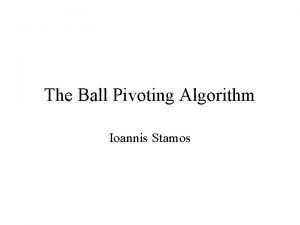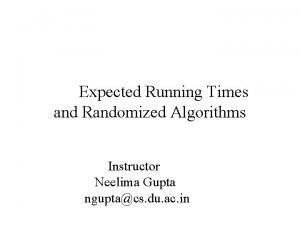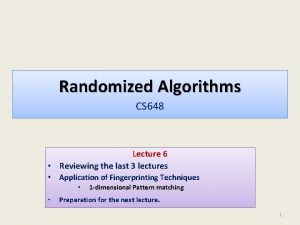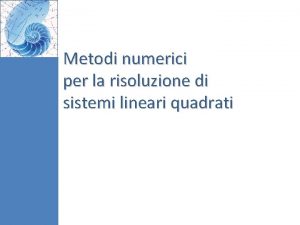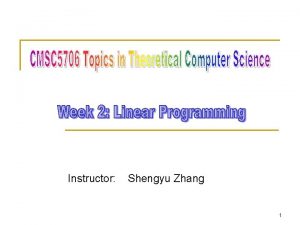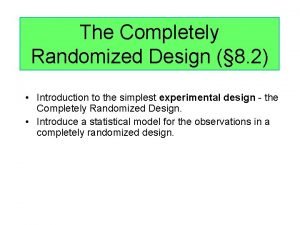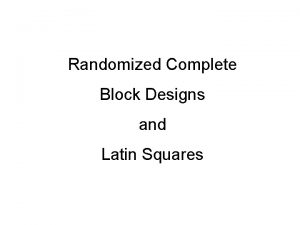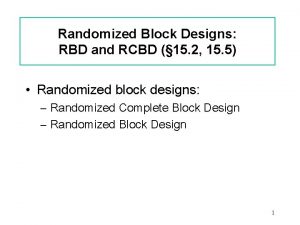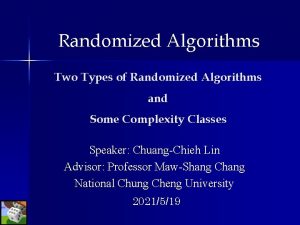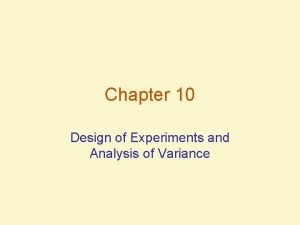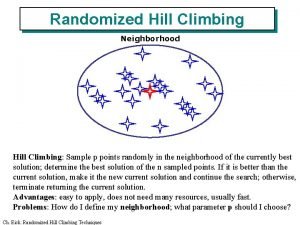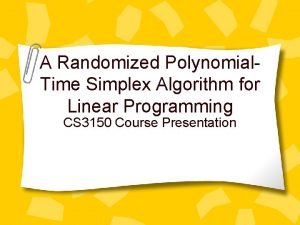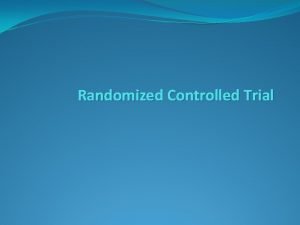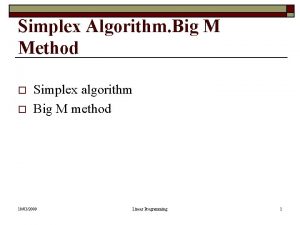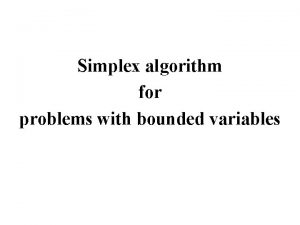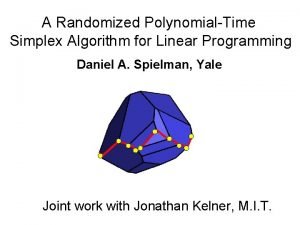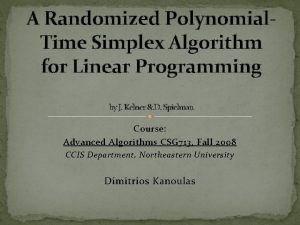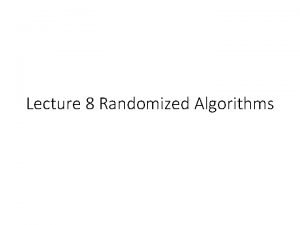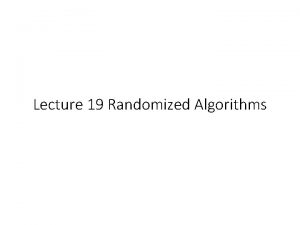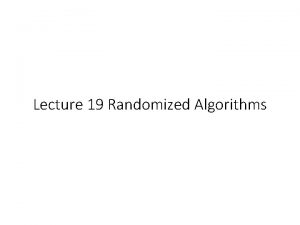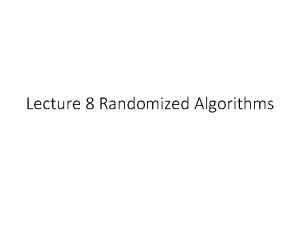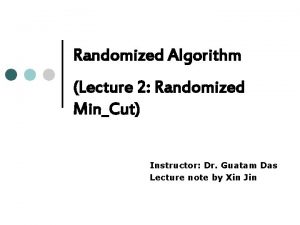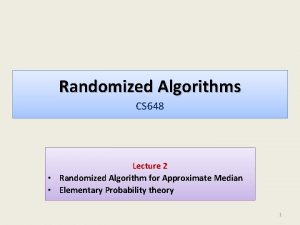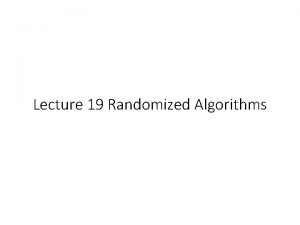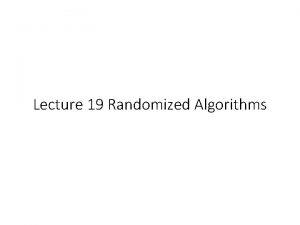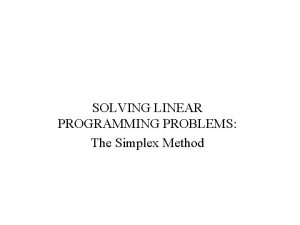Randomized pivoting rules for the simplex algorithm upper


![The Simplex Algorithm [Dantzig (1947)] Start at some vertex. Move up, from vertex to The Simplex Algorithm [Dantzig (1947)] Start at some vertex. Move up, from vertex to](https://slidetodoc.com/presentation_image_h/88307cc9378a7e431dafe03022ac3786/image-3.jpg)


![Algorithms for Linear Programming Simplex [Dantzig 1947] No polynomial version known (yet? ) Polynomial, Algorithms for Linear Programming Simplex [Dantzig 1947] No polynomial version known (yet? ) Polynomial,](https://slidetodoc.com/presentation_image_h/88307cc9378a7e431dafe03022ac3786/image-6.jpg)

![Turn-based 2 -Player 0 -Sum Stochastic Games [Shapley ’ 53] [Gillette ’ 57] … Turn-based 2 -Player 0 -Sum Stochastic Games [Shapley ’ 53] [Gillette ’ 57] …](https://slidetodoc.com/presentation_image_h/88307cc9378a7e431dafe03022ac3786/image-8.jpg)
![Markov Decision Processes [Shapley ’ 53] [Bellman ’ 57] [Howard ’ 60] … When Markov Decision Processes [Shapley ’ 53] [Bellman ’ 57] [Howard ’ 60] … When](https://slidetodoc.com/presentation_image_h/88307cc9378a7e431dafe03022ac3786/image-9.jpg)
![Diameter of polytopes Hirsch Conjecture (1957) Refuted! [Santos (2010)] Diameter is still believed to Diameter of polytopes Hirsch Conjecture (1957) Refuted! [Santos (2010)] Diameter is still believed to](https://slidetodoc.com/presentation_image_h/88307cc9378a7e431dafe03022ac3786/image-10.jpg)



![Randomized pivoting rules Random-Edge Choose a random improving edge [Dantzig (1947)] Random-Facet [Kalai (1992)] Randomized pivoting rules Random-Edge Choose a random improving edge [Dantzig (1947)] Random-Facet [Kalai (1992)]](https://slidetodoc.com/presentation_image_h/88307cc9378a7e431dafe03022ac3786/image-14.jpg)
![Primal Random-Facet [Kalai (1992)] Primal Random-Facet [Kalai (1992)]](https://slidetodoc.com/presentation_image_h/88307cc9378a7e431dafe03022ac3786/image-15.jpg)




![Primal Random-Facet [Kalai (1992)] Primal Random-Facet [Kalai (1992)]](https://slidetodoc.com/presentation_image_h/88307cc9378a7e431dafe03022ac3786/image-20.jpg)



![Dual Random-Facet [Matoušek-Sharir-Welzl (1992)] § Choose a random facet not containing the current (infeasible) Dual Random-Facet [Matoušek-Sharir-Welzl (1992)] § Choose a random facet not containing the current (infeasible)](https://slidetodoc.com/presentation_image_h/88307cc9378a7e431dafe03022ac3786/image-24.jpg)
![Improved Random-Facet [Kalai (1992) (1996)] [Gärtner (1995)] [Hansen-Z (2014)] Improved Random-Facet is (almost) a Improved Random-Facet [Kalai (1992) (1996)] [Gärtner (1995)] [Hansen-Z (2014)] Improved Random-Facet is (almost) a](https://slidetodoc.com/presentation_image_h/88307cc9378a7e431dafe03022ac3786/image-25.jpg)


![(Sub-)Exponential lower bounds Random Edge and Random Facet [Friedmann-Hansen-Z (2011, 2014)] Random-Edge and Random-Facet (Sub-)Exponential lower bounds Random Edge and Random Facet [Friedmann-Hansen-Z (2011, 2014)] Random-Edge and Random-Facet](https://slidetodoc.com/presentation_image_h/88307cc9378a7e431dafe03022ac3786/image-28.jpg)









![Algorithm RANDOM EDGE RANDOM FACET Lower bound Upper bound [Hansen-Z (2016)] [Hansen-Paterson-Z (2014)] Algorithm RANDOM EDGE RANDOM FACET Lower bound Upper bound [Hansen-Z (2016)] [Hansen-Paterson-Z (2014)]](https://slidetodoc.com/presentation_image_h/88307cc9378a7e431dafe03022ac3786/image-38.jpg)


- Slides: 40

Randomized pivoting rules for the simplex algorithm – upper and lower bounds Uri Zwick (武熠) – Tel Aviv University AAAC 2018 Asian Association for Algorithms and Computation

Linear Programming Maximize a linear objective function subject to a set of linear inequalities (and equalities) Find the highest point in a polyhedron
![The Simplex Algorithm Dantzig 1947 Start at some vertex Move up from vertex to The Simplex Algorithm [Dantzig (1947)] Start at some vertex. Move up, from vertex to](https://slidetodoc.com/presentation_image_h/88307cc9378a7e431dafe03022ac3786/image-3.jpg)
The Simplex Algorithm [Dantzig (1947)] Start at some vertex. Move up, from vertex to vertex, along edges, until reaching the top.

Pivoting rules Which up-going edge to take? ? The top will always be reached, but after how many steps?

Deterministic pivoting rules Largest improvement Largest slope Dantzig’s rule – Largest modified cost Bland’s rule (avoids cycling) Lexicographic rule (also avoids cycling) Zadeh’s rule – “least recently entered” All known deterministic pivoting rules require an exponential number of steps, in the worst-case [Klee-Minty (1972)] , … , [Amenta-Ziegler (1996)] [Friedmann (2011)]
![Algorithms for Linear Programming Simplex Dantzig 1947 No polynomial version known yet Polynomial Algorithms for Linear Programming Simplex [Dantzig 1947] No polynomial version known (yet? ) Polynomial,](https://slidetodoc.com/presentation_image_h/88307cc9378a7e431dafe03022ac3786/image-6.jpg)
Algorithms for Linear Programming Simplex [Dantzig 1947] No polynomial version known (yet? ) Polynomial, but not strongly polynomial Not “combinatorial”

Is the simplex algorithm still interesting? The simplex algorithm works very well in practice. Fundamental and intriguing open problems: 1. Is there a polynomial pivoting rule? 2. Is the diameter polynomial? 3. Is Linear Programming strongly polynomial? Simplex-like algorithms can be used to solve more than just LP problems.
![Turnbased 2 Player 0 Sum Stochastic Games Shapley 53 Gillette 57 Turn-based 2 -Player 0 -Sum Stochastic Games [Shapley ’ 53] [Gillette ’ 57] …](https://slidetodoc.com/presentation_image_h/88307cc9378a7e431dafe03022ac3786/image-8.jpg)
Turn-based 2 -Player 0 -Sum Stochastic Games [Shapley ’ 53] [Gillette ’ 57] … [Condon ’ 92] States are divided between two players, max and min. From each state, there is a collection of available probabilistic actions, each with an associated reward. Players try to maximize/minimize total expected reward. Both players have optimal positional strategies Can optimal strategies be found in polynomial time? Best known algorithm is a sub-exponential simplex-like algorithm
![Markov Decision Processes Shapley 53 Bellman 57 Howard 60 When Markov Decision Processes [Shapley ’ 53] [Bellman ’ 57] [Howard ’ 60] … When](https://slidetodoc.com/presentation_image_h/88307cc9378a7e431dafe03022ac3786/image-9.jpg)
Markov Decision Processes [Shapley ’ 53] [Bellman ’ 57] [Howard ’ 60] … When there is only one player, the game is known as a Markov Decision Process. The game ends when the token reaches the sink. Optimal positional strategies can be found using LP Is there a strongly polynomial time algorithm?
![Diameter of polytopes Hirsch Conjecture 1957 Refuted Santos 2010 Diameter is still believed to Diameter of polytopes Hirsch Conjecture (1957) Refuted! [Santos (2010)] Diameter is still believed to](https://slidetodoc.com/presentation_image_h/88307cc9378a7e431dafe03022ac3786/image-10.jpg)
Diameter of polytopes Hirsch Conjecture (1957) Refuted! [Santos (2010)] Diameter is still believed to be polynomial Quasi-polynomial upper bound [Kalai-Kleitman (1992)] ([Todd (2014)])

Vertices, edges and facets Supporting hyperplane: Polytope is on one side. Non-empty intersection. 0 -face – Vertex

Vertices, edges and facets Supporting hyperplane: Polytope is on one side. Non-empty intersection. 0 -face – Vertex 1 -face – Edge

Vertices, edges and facets Supporting hyperplane: Polytope is on one side. Non-empty intersection. 0 -face – Vertex 1 -face – Edge
![Randomized pivoting rules RandomEdge Choose a random improving edge Dantzig 1947 RandomFacet Kalai 1992 Randomized pivoting rules Random-Edge Choose a random improving edge [Dantzig (1947)] Random-Facet [Kalai (1992)]](https://slidetodoc.com/presentation_image_h/88307cc9378a7e431dafe03022ac3786/image-14.jpg)
Randomized pivoting rules Random-Edge Choose a random improving edge [Dantzig (1947)] Random-Facet [Kalai (1992)] [Matoušek-Sharir-Welzl (1992)] To be described shortly Random-Facet is sub-exponential!
![Primal RandomFacet Kalai 1992 Primal Random-Facet [Kalai (1992)]](https://slidetodoc.com/presentation_image_h/88307cc9378a7e431dafe03022ac3786/image-15.jpg)
Primal Random-Facet [Kalai (1992)]


Inactive facet - All vertices on the facet are below the current vertex.

Inactive

![Primal RandomFacet Kalai 1992 Primal Random-Facet [Kalai (1992)]](https://slidetodoc.com/presentation_image_h/88307cc9378a7e431dafe03022ac3786/image-20.jpg)
Primal Random-Facet [Kalai (1992)]

Unusual recurrence relations Unusual 2 D recurrence relations are much harder to analyze, but exhibit similar behavior.

Linear Programming Duality

Linear Programming Duality d variables n inequalities
![Dual RandomFacet MatoušekSharirWelzl 1992 Choose a random facet not containing the current infeasible Dual Random-Facet [Matoušek-Sharir-Welzl (1992)] § Choose a random facet not containing the current (infeasible)](https://slidetodoc.com/presentation_image_h/88307cc9378a7e431dafe03022ac3786/image-24.jpg)
Dual Random-Facet [Matoušek-Sharir-Welzl (1992)] § Choose a random facet not containing the current (infeasible) basic solution (bs). § Solve recursively without this facet, starting from the current basic solution. § If the bs obtained is on the right side of the ignored facet, i. e. , is a vertex, we are done. § Otherwise, do a dual pivoting step to a basic solution on the ignored facet and recurse.
![Improved RandomFacet Kalai 1992 1996 Gärtner 1995 HansenZ 2014 Improved RandomFacet is almost a Improved Random-Facet [Kalai (1992) (1996)] [Gärtner (1995)] [Hansen-Z (2014)] Improved Random-Facet is (almost) a](https://slidetodoc.com/presentation_image_h/88307cc9378a7e431dafe03022ac3786/image-25.jpg)
Improved Random-Facet [Kalai (1992) (1996)] [Gärtner (1995)] [Hansen-Z (2014)] Improved Random-Facet is (almost) a primal algorithm. It is faster than both Primal and Dual Random-Facet. Improved either follows an edge to an adjacent vertex, or jumps back to a previously visited vertex. Improved Random-Facet defines a tree, rather than a path.

Acyclic Unique Sink Orientations (AUSOs) Acyclic orientation of the edges of a polytope such that every face has a unique sink A linear objective function gives rise to an AUSO. Most AUSOs do not correspond to LPs.

Random-Facet on AUSOs The analysis of Random-Facet only uses the AUSO properties. The 2 -player stochastic games define AUSOs. Thus, they can be solved using Random-Facet. Does Random-Facet run faster on LPs? Random-Facet is not polynomial, even for LPs.
![SubExponential lower bounds Random Edge and Random Facet FriedmannHansenZ 2011 2014 RandomEdge and RandomFacet (Sub-)Exponential lower bounds Random Edge and Random Facet [Friedmann-Hansen-Z (2011, 2014)] Random-Edge and Random-Facet](https://slidetodoc.com/presentation_image_h/88307cc9378a7e431dafe03022ac3786/image-28.jpg)
(Sub-)Exponential lower bounds Random Edge and Random Facet [Friedmann-Hansen-Z (2011, 2014)] Random-Edge and Random-Facet are not polynomial even on LPs. Lower bound for Random-Edge obtained on an LP corresponding to a Markov Decision Process (MDP) Lower bound for Random-Facet obtained on an LP corresponding to a Shortest Path problem.

3 -bit counter payoff Decision node (−N)15 Token Randomization node

3 -bit counter 0 1 0

3 -bit counter – Improving switches Random-Edge can choose either one of these improving switches… 0 1 0

Cycle gadgets Cycles close one edge at a time Shorter cycles close faster

Cycle gadgets Cycles open “simultaneously”

3 -bit counter 2 3 0 1 10

3 -bit counter 3 4 0 1 1

Size of cycles Various cycles and lanes compete with each other Some are trying to open while some are trying to close We need to make sure that our candidates win! Can be improved using a more complicated construction and an improved analysis (work in progress)

Randomized Pivoting Rules – Upper and lower bounds Algorithm RANDOM EDGE RANDOM FACET Lower bound Upper bound ? ? ? [Kalai ’ 92] [Matousek-Sharir-Welzl ’ 92] [Friedmann-Hansen-Z (2011, 2014)]
![Algorithm RANDOM EDGE RANDOM FACET Lower bound Upper bound HansenZ 2016 HansenPatersonZ 2014 Algorithm RANDOM EDGE RANDOM FACET Lower bound Upper bound [Hansen-Z (2016)] [Hansen-Paterson-Z (2014)]](https://slidetodoc.com/presentation_image_h/88307cc9378a7e431dafe03022ac3786/image-38.jpg)
Algorithm RANDOM EDGE RANDOM FACET Lower bound Upper bound [Hansen-Z (2016)] [Hansen-Paterson-Z (2014)] [Matousek (1994)] [Gärtner (2002)]

Algorithm RANDOM EDGE RANDOM FACET Lower bound Upper bound

Concluding remarks and open problems Is there a polynomial pivoting rule? Is the diameter polynomial? Is Linear Programming strongly polynomial? Are there better randomized pivoting rules? Is Random-Edge subexponential? Subexponential lower bound for Improved-Random-Facet? Are there deterministic subexponential pivoting rules? Faster algorithms for Turn-based 2 -Player 0 -Sum Stochastic Games?
 Ball-pivoting algorithm
Ball-pivoting algorithm Expected running time
Expected running time Randomized algorithm in daa
Randomized algorithm in daa Pivot element
Pivot element Pivoting parziale esempio
Pivoting parziale esempio Conclusion sentence for intro paragraph
Conclusion sentence for intro paragraph Horseshoe section hair definition
Horseshoe section hair definition Complete pivoting example
Complete pivoting example Simplex algorithm example
Simplex algorithm example Mcnfp examples
Mcnfp examples Simplex method
Simplex method Simplex algorithm runtime
Simplex algorithm runtime Lower bound of 5
Lower bound of 5 Randomized polynomial time
Randomized polynomial time Completely randomized design
Completely randomized design Randomized skip list
Randomized skip list Randomized group design
Randomized group design Difference between rcbd and latin square design
Difference between rcbd and latin square design Randomised block design
Randomised block design Rcbd design example
Rcbd design example Types of randomized algorithms
Types of randomized algorithms Rcbd meaning in research
Rcbd meaning in research Completely randomized design (crd)
Completely randomized design (crd) Randomized hill climbing
Randomized hill climbing Experimental designs
Experimental designs Completely randomized design
Completely randomized design Randomized hill climbing
Randomized hill climbing Contoh rancangan acak kelompok
Contoh rancangan acak kelompok Layout of completely randomized design
Layout of completely randomized design Factorial randomized block design
Factorial randomized block design Probabilistic analysis and randomized algorithms
Probabilistic analysis and randomized algorithms Randomized polynomial time
Randomized polynomial time Advantage of randomized controlled trial
Advantage of randomized controlled trial Nivolumab pronounce
Nivolumab pronounce Randomized block design example
Randomized block design example Kontinuitetshantering i praktiken
Kontinuitetshantering i praktiken Typiska novell drag
Typiska novell drag Nationell inriktning för artificiell intelligens
Nationell inriktning för artificiell intelligens Returpilarna
Returpilarna Shingelfrisyren
Shingelfrisyren En lathund för arbete med kontinuitetshantering
En lathund för arbete med kontinuitetshantering
